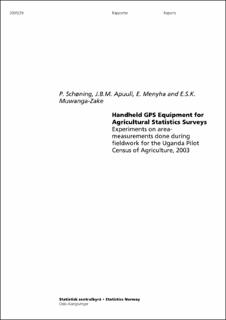| dc.description.abstract | Uganda Bureau of Statistics and Statistics Norway staff jointly conducted fieldwork in Uganda 2003 experimenting
with simple handheld Geographical Positioning System (GPS) tools for determination of agricultural holding areas and
geo-referencing of holdings. NORAD funded this exercise under the "Support to Strengthen Agricultural Statistics"
Program 2002-2005. The objective of the exercise was to test out the feasibility of using a hand held Global
Positioning System (GPS) tool as an alternative instrument for area measurement during agricultural fieldwork in
Uganda. The experiment was conducted as a part of the Pilot Agricultural Census (PCA). More than 900 holdings
distributed in 10 districts of Uganda were visited and parcel and crop plot areas where measured using several
methods. Therefore a substantial number of observations are available for comparative analyses. From the PCA there
are a total of 430 observations where areas of parcels were measured both with GPS and by traversing (tape &
compass). Tape and compass measurements is regarded as the most accurate observation of the ground truth taken
during the experiment. However, a paired T-test of this set of observations reveals that there is minor difference
between the results of GPS use compared to Traversing concerning parcels measured during the PCA fieldwork 2003.
The same conclusion was also drawn when measurement of the smaller crop plot areas were compared. For both
parcel and crop plot areas, the farmers and enumerator's eye-estimates were found not to be reliable. A subset of
191 observations about time use on holdings where both GPS measurements and traversing with tape and compass
was conducted. It can be observed that the average time use per holding for traversing was as much as 3 hours and
23 minutes or 3.5 times as much as when GPS was used. The price of high quality tape and compass equipment was,
at the time of the experiment, approximately 25 USD and 100 USD (compass including jacket) respectively. In
addition a fairly expensive programmable calculator is necessary to calculate areas captured by traversing. The total
price is therefore not so different from the price of the simple handheld GPS tool used. However, battery costs are
high for GPS use, while almost neglectable for traditional traversing. | en_US |
